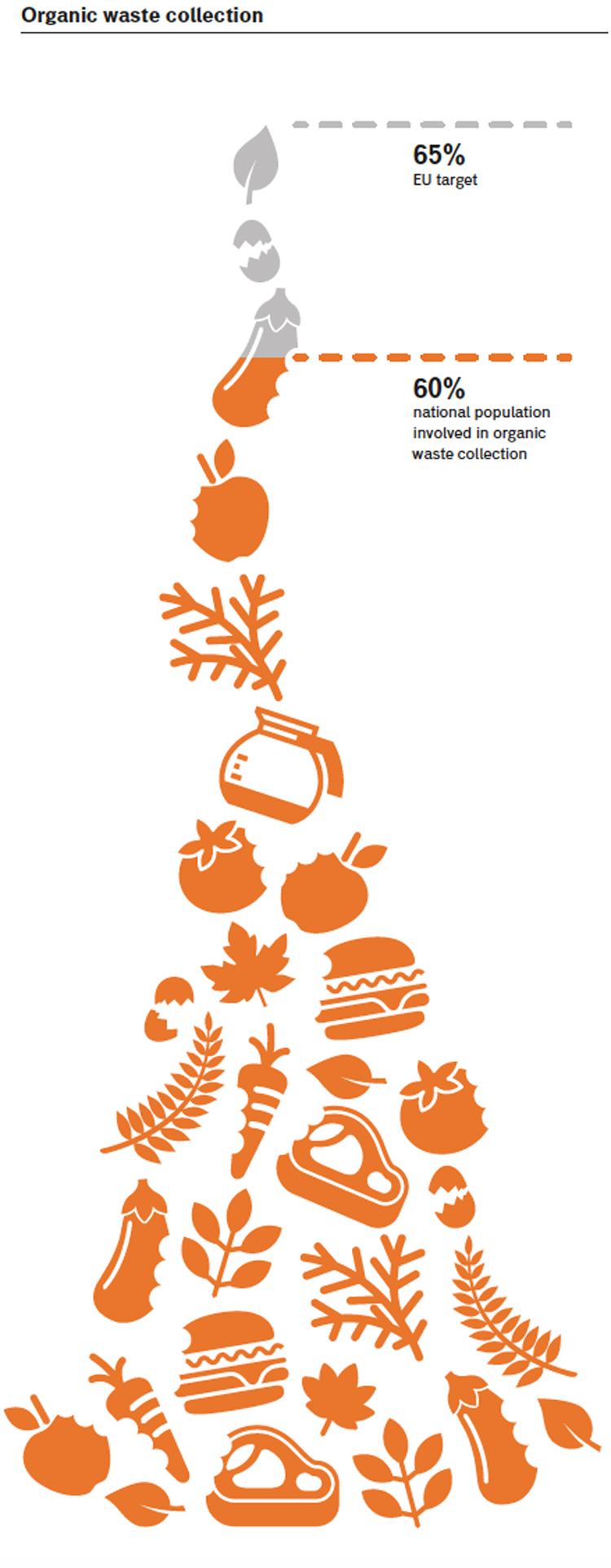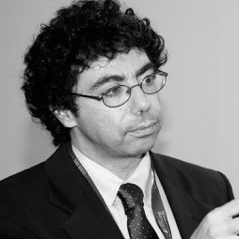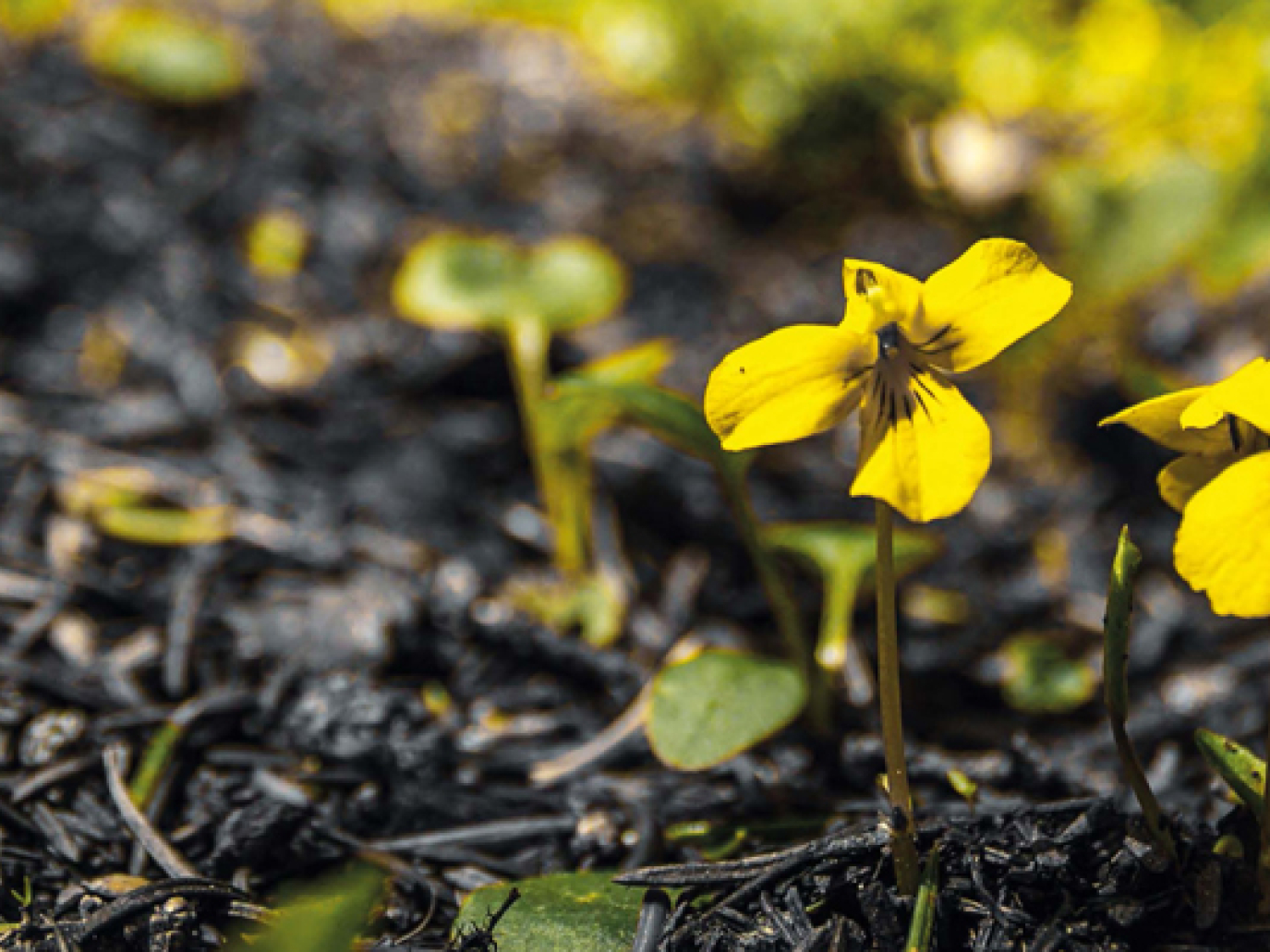Fruit, vegetables, meat, coffee and egg residues. But also tissues and garden waste such as branches, leaves, grass and straw. This is all useful material to make compost, the natural organic fertilizer that can replace mineral fertilizers. And there is more to it. Compost can help offset the loss of organic matter in soils, a phenomenon caused by climate change and intensive farming, affecting many areas in Southern Europe, including Italy; an added value that up until now has not been spotted by policy makers.
Compost is an excellent natural organic fertilizer that can wholly replace phosphorous and potassium-based mineral fertilizers, and partly also the nitrogen-based ones. Compost’s production process, an aerobic process lasting a few weeks, is self-activated during the crushing and the bacterial action phases, thanks to which temperatures between 60-70 °C are reached. Therefore, it does not require chemicals, additives or external energy sources, as opposed to what happens with synthetic fertilizers.
Not only does compost help make agriculture more sustainable by limiting the use of traditional fertilizers, but it can also play a role in soil protection because it becomes part of soils’ organic matter. Indeed, the latter is the most important contributor of soil fertility. Made of living organisms present in the soil and the remains of dead organisms in various stages of decomposition, the organic matter augments the soil ability to absorb nutrients. Not only that; it also reduces the risk of soil compaction and superficial erosion because it can absorb considerable amounts of water and contributes to the dispersal of pollutants that may permeate soils.
Carbon in Soils
Over the last decades, the phenomenon of the progressive loss of organic matter in soils has intensified, mainly due to two factors: temperature rise caused by climate change (decomposition of organic matter occur more rapidly with higher temperatures) and intensive agriculture, involving frequent tillage and overexploitation of soils. According to the EC’s JRC (Joint Research Centre), almost half of European soils have very low contents of organic matter, in particular in Southern Europe and in some areas of France, United Kingdom and Germany.
In addition, less organic matter in the soil means more CO2 in the atmosphere. When organic matter is formed, the soil absorbs carbon dioxide from the atmosphere: it is estimated that the soil contains about double the amount of carbon present in the air and three times as much of that retained by vegetation (European soils contain about 75 billion tonnes of organic carbon). Vice versa, when organic matter decomposes, the soil releases carbon dioxide into the atmosphere.
“In some Italian areas, over the last 30 years, the amount of organic matter in the soil has halved: this means that the biological potential, fertility and the value of the soil itself have also diminished by half,” Massimo Centernero, CIC (Italian Compost Consortium) claims. “The situation is also worrying in other countries in Southern Europe: the ideal organic matter level must be restored, even though it cannot be done immediately, because it takes decades for organic matter to be recreated. Here compost comes into play. Together with more sustainable agricultural practices, it represents one of the elements that can restore organic carbon into the soil, thus contributing to replenish it with organic matter, guaranteeing high levels of natural fertility in soils. This issue is flatly ignored by policy makers, as no initiative to exploit compost as a resource has even been taken, except for sporadic measures taken in some regions for rural development plans.”
“I am in no position to say” continues Massimo Centemero, “if the solution would be the introduction of a system of incentives such as that adopted for renewable sources, but policy makers should realize that companies in our consortium actually produce renewable fertilizers. Our production chain has been overlooked by politics. The creation of CIC, which occurred a little over 20 years ago thanks to the voluntary commitment of some companies, confirms this. Over the years, the organic supply chain has expanded as well as activities carried out by consortia. Nobody tried to structure this system, we are trying to do that on a voluntary basis: so, this sector was born, has developed and expanded under its own steam.”
The Consortium Promoting Quality Compost
The Italian Compost Consortium (CIC) is a non-profit organization that groups businesses, private and public institutions active in the compost production sector. Its nearly 100 members represent about 90% of the compost manufactured in Italy. The Consortium’s objectives include the promotion of composted materials, with special focus on high quality and controlled quality materials, the appropriate use of high quality materials in agriculture, the protection and control of correct methodologies and procedures to produce composted materials, research activity, study and popularization, organization of training and recurrent courses on composting and product use. The Consortium takes part in technical and work groups with ministries and local administrations; it is also a member of the European Compost Network. “We promoted a Manifesto for the Mediterranean, also dealing with the protection of the organic matter in the soil,” Massimo Centemero explains. “Moreover, we created a Mediterranean Compost Network in Mediterranean countries, a basing including areas with similar climatic characteristics: hot summers, mild winters, organic matter scarcity, pre-desertification phenomena and tourism-orientated areas. The European Association will be very busy in 2016, having to deal with the circular economy package, the new European regulations on fertilizers and the classification of end-of-waste criteria.”
High Quality Brand
Not all compost available on the market is the same: it can be divided in two categories. The first one is “green compost,” derived from vegetable waste of public and private green and replaces peat imports, mainly for the floricultural market. The second is “mixed compost”, obtained both from kitchen wet waste, public green and gardens; it is very rich in nutrients and is used for the formulation of fertilizers in agriculture. As guidance for compost buyers, in 2004 CIC introduced a high quality brand linked to the product (and not to the production process). In 2014, such brand covered 37% of national production: in the Italian 252 composting plants, over 1 million tonnes of compost a year is produced.
“Almost 50 companies can boast such brand: we deal with the organization, while the monthly sampling and the lab tests are carried out by third parties,” Centemero points out. “All compost on the Italian market must abide by the law on fertilizers as to its chemical and physical characteristics, but the added value of our brand is determined by the high number of samples and independent analyses. Thanks to the 2,500 analyses we conducted over the years, we managed to build a huge database. Recently, in Italy, the number of anaerobic digestion plants is rising (46 at the end of 2014), where besides compost biogas and cogenerated electricity are also produced. Although with considerable investments, the new frontier is the transformation of biogas into biomethane, which can be used both for the domestic and transport sectors.”
Organic Waste Collection has Been on the Rise for Twenty Years
Organic waste treatment for the production of compost is a sector that does not seem to have been affected by the economic and financial crisis, it actually has guaranteed good profits for investors: a considerable share of such income has been invested in technological innovation.
If, in the past, compost was only produced from vegetable waste, later on kitchen wet waste and then anaerobic digestion were introduced to produce biogas. Numbers speak for themselves. In 2014, the total of urban waste separate waste collection amounted to 13.4 million tonnes: the largest fraction is represented by organic waste collection (5.7 million tonnes), 42.5% of the total. Between 2013 and 2014, organic waste collection grew by 9.5%, but the trend has been positive for twenty years now, with a value always higher than 5%, from one year to the next. Such increase is due to the fact that an ever increasing number of municipalities carry out separate waste collection, especially that of organic waste. The bulk of 2014 growth, close to 10%, was determined by organic waste collection, which is now operational everywhere in Milan that, with its 1.3 million inhabitants significantly influenced the national average.
“In Italy, the organic fraction collected is very good, even higher considering the amount per inhabitant, than that of some countries of Northern or Central Europe,” Massimo Centemero explains. “Today, the organic collection involves between 35 and 40 million Italians, about 60% of the total Italian population: we must be able to reach the remaining share of people if we are to achieve the 65% of separate waste collection EU target, considering the organic waste’s crucial contribution. Southern Italy is still lagging behind; in some areas in the South, separate waste collection is almost inexistent, mainly in Sicily and Calabria, even though in others (for example in Campania, in the Salerno provinces, Avellino and Benevento) very good rates of collection are achieved. Collection must be further developed in large cities too, where it is more difficult to manage due to the level of urbanization: there is a need to revise collection timetable and adjust the collection vehicles. But the Milan example showed that the organic fraction can be collected, citizens have responded very well. In Milan, as everywhere else, the success of separate waste collection depended on them.”

Developing the Compost Supply Chain
The most urgent action to take is to reach out to those areas where the organic waste collection does not achieve the desired result. But what is the best strategy to adopt? “The industrial sector, with the construction of composting plants, must set things in motion hand in hand with the development of separate waste collection,” Centemero concludes. “If the organic collection is already happening but the treatment plants are missing, it is a major problem because it is necessary to transport waste for hundreds of kilometres to the nearest plant and in the long run this could hinder the development of this sector. By the same token, plants without material to be treated would be equally harmful. There is no single best solution suitable for all eventualities: there are virtuous examples that have originated from public as well as private initiatives. In the North of Italy, starting from the waste emergency of some years ago, most provinces took it upon themselves to build special plants, with enough infrastructure, which could be enhanced in the future because there are regions such as Liguria and some other areas, where organic separate waste collection does not occur. There, incentivising policies need to be set up with regard to the use of compost, which, let us remember, restores organic fertility and important nutrients into the soil. Besides its economic value, linked to the market price with variations according to the areas, the environmental value that compost has in restoring carbon into the soil should not be neglected. All this is consistent with the circular economy principles that are guiding the decisions of the forthcoming European regulations.”
Consorzio italiano compostatori, www.compost.it
European Compost Network, www.compostnetwork.info



